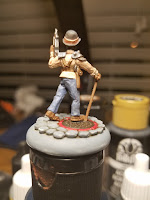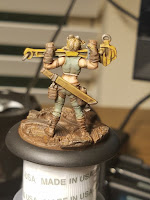When a veteran calls...answer.
 |
| Flag damage |
Recently, a colleague had the misfortune of some significant damage done to a statue of his. Command Master Sergeant Louis Barnes thought his retirement statue would be safe, but a strong gust of wind and down it tumbled off of his desk. This statue seemed heavy, but it turns out that all of the weight was in the wood base, so when the wind picked up; down went the statue to a crashing disaster.
Lou and I were, at the time, colleagues at Metters, Inc. which is now unfortunately closed (Lou is starting a new security company
Barnes Security Solutions, LLC if you need assistance in the Orlando, FL area). Lou had originally asked our model shop lead if he could be of assistance, but was redirected to me given my hobby of small toy soldiers. Now Lou's soldier statue stands about 18" high all told, so a far cry from the 1" figures I usually manage.
Damage Done
 |
| Base damage |
When Lou approached me, I was nervous to agree and so asked him to bring it into the office so that I could take a look at the damage. I am no sculptor and by no means a professional. Lou had attempted a self-repair, but could not get all of the little bits reattached and the gaps filled.
 |
| Foot damage |
The biggest concerns for me were the damage to the flag. This was a pretty significant gap and a number of large cracks running up and down the flag. The access the parts of the flag that were damaged were obstructed by the head of the statue.
The other concern was the damage to the foot. This was mainly a concern because it was a more complex area with the laces and boot sections. The gap, while relatively small, was combined with a crack that went from one side to the other then across the front to the toe. The crack was thin and already glued back together so fixing that area was concerning.
 |
| Flag damage |
The least of the concerns was the damage to the base. This overall was the least complex. It was a rather flat area with some scratch marks within the general area. The area was large, but all in all seemed like a pretty straight forward correction. The only potential concern would be the adherence of the materials to the base.
The statue is made of plaster, so the material was not too much of a concern. The larger issue was the paints. As I stated pretty clearly, I am colorblind so I had a significant concern with selecting the correct colors to match the under color and the and the bronzing. This was after some especially difficult times at Metters with work on one of the military trainers where we had a major issue with the customers original selection for a copper pipe versus what would actually be seen in the real world.
Healing Process
 |
| Reporting for duty |
After the review of the statue in person, I decided to give it a go. The alternative was for Lou to ship it off to someone at an exorbitant rate to get fixed. I was fairly confident that I would be able to restore it to a more than fair condition and set it right back to Lou.
I started with the easiest first, the base. This was to get the mix of plaster (Merlin's ) correct and to gets my hands dirty again with the plaster. Once I had the mix right, I was able to apply using my dental picks. These were the perfect tools to work the plaster. After filling in the space, it was a matter of letting the plaster dry a bit and then marking it to look much like the other scratches.
 |
| Firm base support |
With the work on the base done, I moved onto the boots. The hole filling was pretty easy, but then the next step was the work on the boots. This made me a bit more nervous with the laces. The hole was pretty easy to correct, but the crack through the laces needed a little more work. I managed to get most of the crack filled with a little texture work to make the laces match. The repair work previously done made the crack hard to conceal entirely, but I managed to get enough plaster around it to make it shelf worthy. The repair wasn't perfect, but it was concealed enough so as not to notice from more than a foot away. There was one area of the boot that needed a little more touch up following the plaster work, and for that I needed a little more of a pliable material and used some Gale Force 9 green stuff. This allowed me to work the material into a small space without affecting the boot surrounding.
The flag being the most difficult, was saved for last. I started with some plaster work to fill the largest of the gaps. The size of the space and the empty space within the statue made for some shrinkage. I had to go back with a second set of plaster after the first batch had dried. This didn't address all of the issues though and a significant crack remained along the fold of the flag nearest to the statues head.
 |
| Flag bearer |
For this area, I had to do some work with the green stuff. The crack needed a few goes to get the length filled with green stuff and then worked flat. The overall result was a rather seamless set of joints in the flag, base, and the boots. The crack was slightly visible with close inspection, but not much else could be done for it.
The paint match, my personal biggest challenge, took much more time than the fixes to plaster and cracks. After going through every paint that I had for my tiny soldier painting, I starting going through the color ranges of Reaper, Vallejo, and P3. My search was fruitless. I spent the better part of 3 weeks looking at paints online, at Walmart, Target, Lowe's, Michael's. Pretty much at any location where I could see paints. Finally with a trip to Hobby Lobby for some Christmas decorations with my wife and the Command Master Sergeant statue in tow, she was able to help me find a match.
 |
| Bearer of Arms |
With a large selection of craft paints, she narrowed to a few options. The final selection for the matching base color was Folk Art Acrylic Cocoa (6498) and for the bronzing, Metallic Chocolate Brown (2570). I applied the Cocoa with a brush, Windsor and Newton Series 7 #2. For the bronzing, I would add with a brush to the high point and then rub it onto the statue with my finger. This seemed to allow me to hit the high points with the bronzing color without running into a channel. Overall, the statue turned out quite well and my wife and kids did the primary QC for me.
The other day, I got to meet up with Lou and discuss how things were and present to him the Command Master Sergeant statue once again. He was thrilled and hopefully it will complete his home office. I am glad I was able to do a small bit of good for Lou, who did so much for our country over his career with the Army.
 Living in Florida, I thought the first thing that I should put together is something with an orange tree. The basic requirements are a hotel key card, some Alene's tacky glue, Woodland Scenics Scenic Cement, Woodland Scenics Blended Turf, and a Woodland Scenics Woodland Classics Orange Tree (N, HO, O Scale).
Living in Florida, I thought the first thing that I should put together is something with an orange tree. The basic requirements are a hotel key card, some Alene's tacky glue, Woodland Scenics Scenic Cement, Woodland Scenics Blended Turf, and a Woodland Scenics Woodland Classics Orange Tree (N, HO, O Scale). Once set, I watered down some of the scenic cement with water to make a spray adhesive. Remove the tree from the tree base for this part. Spray the entirety of the card with the watered down scenic cement. When covered well, you will then sprinkle on the blended turf. I used newspaper as my work surface so that I could recover any turf that did not adhere to limit any loss.
Once set, I watered down some of the scenic cement with water to make a spray adhesive. Remove the tree from the tree base for this part. Spray the entirety of the card with the watered down scenic cement. When covered well, you will then sprinkle on the blended turf. I used newspaper as my work surface so that I could recover any turf that did not adhere to limit any loss.


























